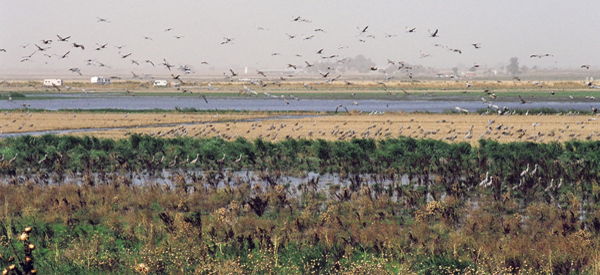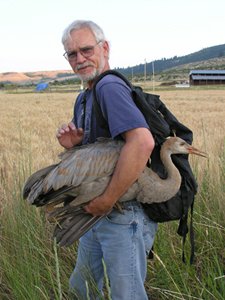
Proposed tunnels to re-route water from the Sacramento River will affect Staten Island,
an important wintering area for Sandhill Cranes in central California.
 ICF Research Associate Gary Ivey (left) works on Sandhill Crane conservation issues in the western United States. His PhD studies focused on the ecology of wintering cranes in the Sacramento-San Joaquin Delta region of California. His past projects include research on crane migration routes from breeding areas to wintering sites, effects of land management on crane nesting success, distribution of breeding cranes in western states, and assistance with Sandhill Crane recovery plans in Washington and California.
ICF Research Associate Gary Ivey (left) works on Sandhill Crane conservation issues in the western United States. His PhD studies focused on the ecology of wintering cranes in the Sacramento-San Joaquin Delta region of California. His past projects include research on crane migration routes from breeding areas to wintering sites, effects of land management on crane nesting success, distribution of breeding cranes in western states, and assistance with Sandhill Crane recovery plans in Washington and California.
A proposed project to re-route Sacramento River water around the Sacramento-San Joaquin Delta to southern California has created controversy about the project’s impact on wildlife habitat, including critical wintering areas for Sandhill Cranes. Since 2010, ICF Research Associate Gary Ivey has been a sub-consultant on the project, providing research data and recommendations to help lessen the project’s impact on cranes and their habitats.
The proposed water tunnel system would go through Staten Island, a 9,200 acre corporate farm in central California owned by The Nature Conservancy. The area is protected by a conservation easement, which focuses on maintaining wintering crane habitat. Staten Island is likely the most important wintering site for Sandhill Cranes in California, supporting about 20% of the state-threatened Greater Sandhill Cranes.
Many conservation groups oppose the selection of the tunnel route under Staten Island out of concern for the cranes. Since the water tunnels will be underground, the actual footprint of the development on Staten Island only will be about 27 acres after completion. However, over the ten year construction period, there will be significant construction noise and disturbance, which will likely deter crane use on large areas of the island. Other threats to cranes include temporary power lines, which could increase crane mortality from collisions, as well as loss of crane foraging habitat where soil displaced by the tunnels is temporarily stored.
Gary is continuing to work with a team of biologists on minimizing the effects on cranes from the project. The team has identified areas with the highest densities of cranes in the Delta and has provided recommendations for new conservation measures, including developing new refuge areas for cranes in the region. In addition, the team has recommended protection of the surrounding agricultural landscape through conservation easements – to prevent crane foraging habitat loss and encourage wildlife-friendly farming. Gary also has developed a model to estimate crane mortalities from collisions with proposed new power lines and made recommendations for marking existing lines to reduce collisions.
“I think ICF’s role is to provide the decision-makers with good science so cranes end up on the winning side of this project. If all the crane conservation measures we have developed are implemented, the cranes benefit from more protected areas and improved habitat in the region into the future,” Gary said.
